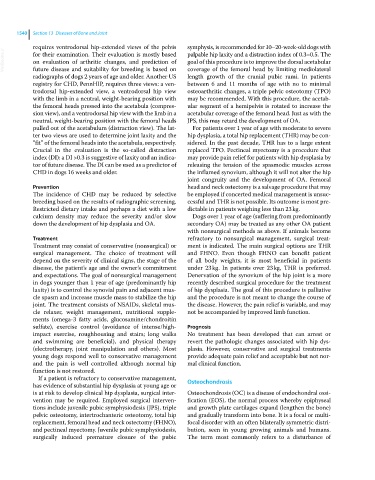Page 1602 - Clinical Small Animal Internal Medicine
P. 1602
1540 Section 13 Diseases of Bone and Joint
requires ventrodorsal hip‐extended views of the pelvis symphysis, is recommended for 10–20‐week‐old dogs with
VetBooks.ir for their examination. Their evaluation is mostly based palpable hip laxity and a distraction index of 0.3–0.5. The
goal of this procedure is to improve the dorsal acetabular
on evaluation of arthritic changes, and prediction of
future disease and suitability for breeding is based on
length growth of the cranial pubic rami. In patients
radiographs of dogs 2 years of age and older. Another US coverage of the femoral head by limiting mediolateral
registry for CHD, PennHIP, requires three views: a ven- between 6 and 11 months of age with no to minimal
trodorsal hip‐extended view, a ventrodorsal hip view osteoarthritic changes, a triple pelvic osteotomy (TPO)
with the limb in a neutral, weight‐bearing position with may be recommended. With this procedure, the acetab-
the femoral heads pressed into the acetabula (compres- ular segment of a hemipelvis is rotated to increase the
sion view), and a ventrodorsal hip view with the limb in a acetabular coverage of the femoral head. Just as with the
neutral, weight‐bearing position with the femoral heads JPS, this may retard the development of OA.
pulled out of the acetabulum (distraction view). The lat- For patients over 1 year of age with moderate to severe
ter two views are used to determine joint laxity and the hip dysplasia, a total hip replacement (THR) may be con-
“fit” of the femoral heads into the acetabula, respectively. sidered. In the past decade, THR has to a large extent
Crucial in the evaluation is the so‐called distraction replaced TPO. Pectineal myectomy is a procedure that
index (DI): a DI >0.3 is suggestive of laxity and an indica- may provide pain relief for patients with hip dysplasia by
tor of future disease. The DI can be used as a predictor of releasing the tension of the spasmodic muscles across
CHD in dogs 16 weeks and older. the inflamed synovium, although it will not alter the hip
joint congruity and the development of OA. Femoral
Prevention head and neck ostectomy is a salvage procedure that may
The incidence of CHD may be reduced by selective be employed if concerted medical management is unsuc-
breeding based on the results of radiographic screening. cessful and THR is not possible. Its outcome is most pre-
Restricted dietary intake and perhaps a diet with a low dictable in patients weighing less than 23 kg.
calcium density may reduce the severity and/or slow Dogs over 1 year of age (suffering from predominantly
down the development of hip dysplasia and OA. secondary OA) may be treated as any other OA patient
with nonsurgical methods as above. If animals become
Treatment refractory to nonsurgical management, surgical treat-
Treatment may consist of conservative (nonsurgical) or ment is indicated. The main surgical options are THR
surgical management. The choice of treatment will and FHNO. Even though FHNO can benefit patient
depend on the severity of clinical signs, the stage of the of all body weights, it is most beneficial in patients
disease, the patient’s age and the owner’s commitment under 23 kg. In patients over 23 kg, THR is preferred.
and expectations. The goal of nonsurgical management Denervation of the synovium of the hip joint is a more
in dogs younger than 1 year of age (predominantly hip recently described surgical procedure for the treatment
laxity) is to control the synovial pain and adjacent mus- of hip dysplasia. The goal of this procedure is palliative
cle spasm and increase muscle mass to stabilize the hip and the procedure is not meant to change the course of
joint. The treatment consists of NSAIDs, skeletal mus- the disease. However, the pain relief is variable, and may
cle relaxer, weight management, nutritional supple- not be accompanied by improved limb function.
ments (omega‐3 fatty acids, glucosamine/chondroitin
sulfate), exercise control (avoidance of intense/high‐ Prognosis
impact exercise, roughhousing and stairs; long walks No treatment has been developed that can arrest or
and swimming are beneficial), and physical therapy revert the pathologic changes associated with hip dys-
(electrotherapy, joint manipulation and others). Most plasia. However, conservative and surgical treatments
young dogs respond well to conservative management provide adequate pain relief and acceptable but not nor-
and the pain is well controlled although normal hip mal clinical function.
function is not restored.
If a patient is refractory to conservative management,
has evidence of substantial hip dysplasia at young age or Osteochondrosis
is at risk to develop clinical hip dysplasia, surgical inter- Osteochondrosis (OC) is a disease of endochondral ossi-
vention may be required. Employed surgical interven- fication (EOS), the normal process whereby epiphyseal
tions include juvenile pubic symphysiodesis (JPS), triple and growth plate cartilages expand (lengthen the bone)
pelvic osteotomy, intertrochanteric osteotomy, total hip and gradually transform into bone. It is a focal or multi-
replacement, femoral head and neck ostectomy (FHNO), focal disorder with an often bilaterally symmetric distri-
and pectineal myectomy. Juvenile pubic symphysiodesis, bution, seen in young growing animals and humans.
surgically induced premature closure of the pubic The term most commonly refers to a disturbance of

